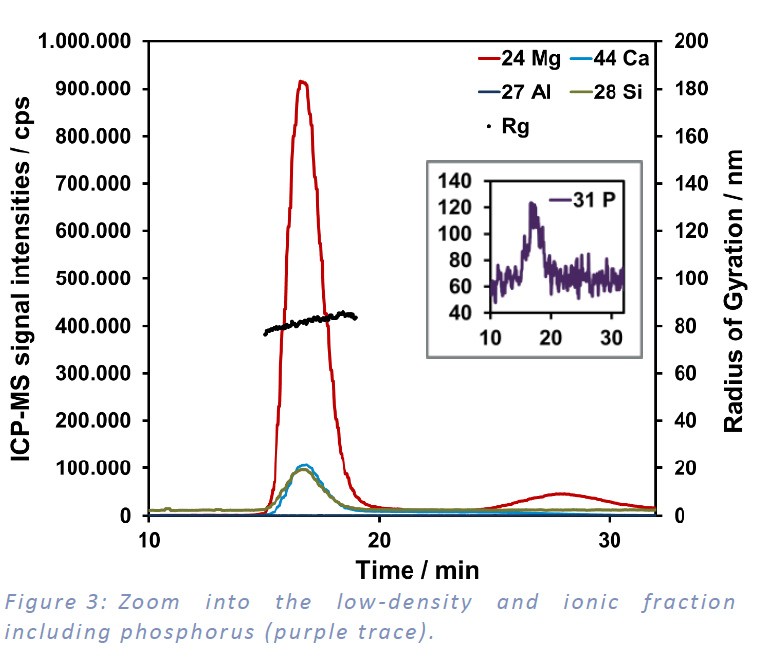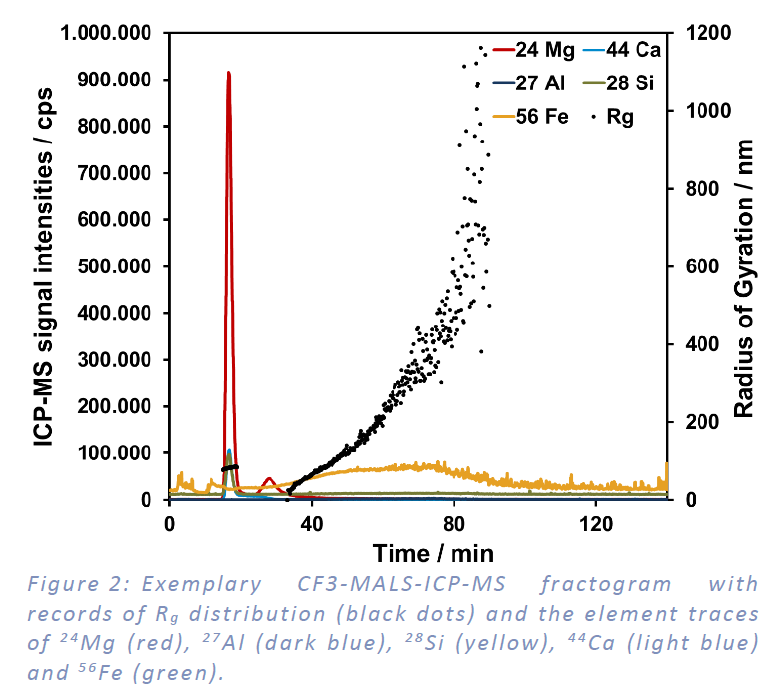Introduction
Assessing particle size and mass distribution as well as elemental composition of suspended matter in environmental water samples is a challenging task [1]. In order to properly address such complex samples, a respective analytical approach has to cover a broad range of particle sizes along with the capability to quantify various elements at significantly different concentration levels. In addition, this methodology should also be able to analyze such samples with no or only minor sample preparation requirements and ideally in a single measurement run.
With a separation range from roughly 10 nm to 30 μm, depending on the density of the sample components, Centrifugal Field-Flow Fractionation (CF3) covers such broad particle size and mass ranges. Hyphenation with Multi-Angle Light Scattering (MALS) and Inductively-Coupled Plasma Mass Spectrometry (ICP-MS) detection additionally enables the determination of size [2] and elemental distributions [3] across the fractionated sample.
Here we show the analysis of samples collected from the third largest freshwater lake in China, Lake Taihu, located in the Yangtze delta close to Shanghai. It is heavily impacted by pollution and eutrophication. Since it is the drinking water reservoir for millions of people there is a great interest in investigating water quality and understanding the processes in the lake, for example to predict algal and bacterial blooms.
Experimental
Via CF3 the sample was separated according to size and density. An exponential decay of the centrifugal field from 4900 rpm to 60 rpm over the course of 160 min was used in a channel with a height of 250 μm. The water samples were analyzed without any further pretreatment step except for manually shaking before injection. 200 μL were injected.
Online hyphenation of CF3 with MALS and ICP-MS enabled size determination respectively elemental characterization of the sample constituents in a single measurement. The evaluation of the intensity distribution of scattered light at 18-20 MALS angles via Rayleigh-Gans-Debye approximation and a fit with the Random Coil Model provided the Radius of Gyration Rg. ICP-MS enabled the simultaneous recording of multiple elements, e.g. 24Mg, 27Al, 28Si, 31P, 44Ca, 56Fe. Elemental quantification was performed by post-channel calibration [4].

Results
CF3 indicates two major size fractions in the sample and MALS provides the size of both fractions. Besides size, CF3 first and foremost separates by mass and density differences. Therefore, fractionation of low from high density materials of similar size could be performed, which wouldn’t be achievable by Asymmetrical Flow Field-Flow Fractionation (AF4). ICP-MS simultaneously enabled access to the size resolved distribution of elements such as magnesium, calcium, aluminum, iron and silicon (Figure 2).
The fraction with the lower density and a size distribution of approx. 80-100 nm Rg elutes first and contains significant amounts of magnesium and calcium and minor traces of elemental phosphorus close to or below the limit of detection of the ICP-MS (Figure 3). This fraction can most likely be correlated to natural organic matter such as humic or fulvic acids.
The second fraction showed a significantly higher density than the first fraction with a size distribution of approx. 130-400 nm Rg dominated by elements such as Si, Al and Fe indicating significant amounts of suspended inorganic sediment particles (Figure 4).


Conclusion
CF3-MALS-ICP-MS is a powerful tool for the separation and characterization of suspended particulate matter in environmental water samples over a broad size and mass range. Analysis can be performed with virtually no sample preparation that may compromise the initial state of the sample and many elements can be analyzed and quantified in parallel. Due to the low sensitivity of the ICP-MS for 31P, quantification of particulate phosphorus enabling monitoring of the nutrient distribution in the water column remains challenging. AF4 might be a promising alternative as it can handle larger sample volumes and enables sample enrichment directly in the AF4 channel. However, this comes at the expense of a lower resolution and applicable size range that may necessitate sample filtration prior to analysis.
References
1] J. Yang, P. Tan, T. Huang, V. Nischwitz, Analytica Chimica Acta, 2020, 1093, 16-27.
[2] V. Sogne, F. Meier, T. Klein, C. Contado, Journal of Chromatography A, 2017, 1515, 196-208.
[3] F. Dutschke, J. Irrgeher, D. Pröfrock, Analytical Methods, 2017, 9(24), 3626-3625.
[4] J. Yang, P. Tan, T. Huang, V. Nischwitz, Analytica Chimica Acta, 2020, 1093, 16-27.
Acknowledgements
Financial support by the BMBF in the frame of the Sino-German Water Supply Network project SIGN2 (BMBF Grant No. 02WCL1471K) is gratefully acknowledged (http://www.water-sign.de).


